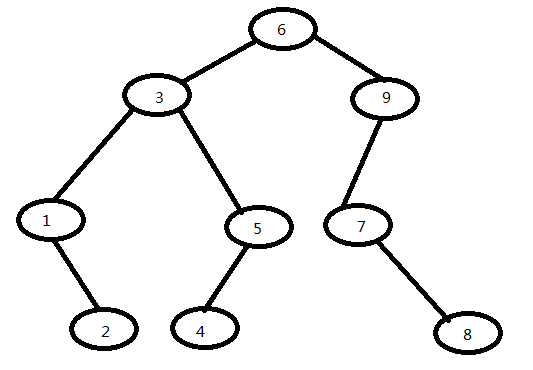以下是我要解析的一个二叉树的模型形状

接下来废话不多直接上代码
一种是用递归的方法,另一种是用堆栈的方法:
首先创建一棵树:
节点对象:
1 public class Node { 2 //节点数值 3 private int data; 4 //左子节点 5 private Node leftNode; 6 //右子节点 7 private Node rightNode; 8 9 public Node(int data, Node leftNode, Node rightNode) { 10 this.data = data; 11 this.leftNode = leftNode; 12 this.rightNode = rightNode; 13 } 14 15 public int getData() { 16 return data; 17 } 18 19 public void setData(int data) { 20 this.data = data; 21 } 22 23 public Node getLeftNode() { 24 return leftNode; 25 } 26 27 public void setLeftNode(Node leftNode) { 28 this.leftNode = leftNode; 29 } 30 31 public Node getRightNode() { 32 return rightNode; 33 } 34 35 public void setRightNode(Node rightNode) { 36 this.rightNode = rightNode; 37 } 38 }
递归方式,实现树的遍历:
1 public class BinaryTreeWithNode1 { 2 3 /** 4 * 二叉树的先序中序后序排序 5 */ 6 public Node init() {//注意必须逆序建立,先建立子节点,再逆序往上建立,因为非叶子结点会使用到下面的节点,而初始化是按顺序初始化的,不逆序建立会报错 7 Node J = new Node(8, null, null); 8 Node H = new Node(4, null, null); 9 Node G = new Node(2, null, null); 10 Node F = new Node(7, null, J); 11 Node E = new Node(5, H, null); 12 Node D = new Node(1, null, G); 13 Node C = new Node(9, F, null); 14 Node B = new Node(3, D, E); 15 Node A = new Node(6, B, C); 16 return A; //返回根节点 17 } 18 19 public void printNode(Node node) { 20 System.out.print(node.getData()); 21 } 22 23 public void theFirstTraversal(Node root) { //先序遍历 24 printNode(root); 25 if (root.getLeftNode() != null) { //使用递归进行遍历左孩子 26 theFirstTraversal(root.getLeftNode()); 27 } 28 if (root.getRightNode() != null) { //递归遍历右孩子 29 theFirstTraversal(root.getRightNode()); 30 } 31 } 32 33 public void theInOrderTraversal(Node root) { //中序遍历 34 if (root.getLeftNode() != null) { 35 theInOrderTraversal(root.getLeftNode()); 36 } 37 printNode(root); 38 if (root.getRightNode() != null) { 39 theInOrderTraversal(root.getRightNode()); 40 } 41 } 42 43 44 public void thePostOrderTraversal(Node root) { //后序遍历 45 if (root.getLeftNode() != null) { 46 thePostOrderTraversal(root.getLeftNode()); 47 } 48 if (root.getRightNode() != null) { 49 thePostOrderTraversal(root.getRightNode()); 50 } 51 printNode(root); 52 } 53 54 public static void main(String[] args) { 55 BinaryTreeWithNode1 tree = new BinaryTreeWithNode1(); 56 Node root = tree.init(); 57 System.out.println("先序遍历"); 58 tree.theFirstTraversal(root); 59 System.out.println(""); 60 System.out.println("中序遍历"); 61 tree.theInOrderTraversal(root); 62 System.out.println(""); 63 System.out.println("后序遍历"); 64 tree.thePostOrderTraversal(root); 65 System.out.println(""); 66 } 67 68 }
堆栈方式,实现树的遍历:
1 import java.util.Stack; 2 3 4 public class BinaryTreeWithNode2 { 5 6 7 public Node init() {//注意必须逆序建立,先建立子节点,再逆序往上建立,因为非叶子结点会使用到下面的节点,而初始化是按顺序初始化的,不逆序建立会报错 8 Node J = new Node(8, null, null); 9 Node H = new Node(4, null, null); 10 Node G = new Node(2, null, null); 11 Node F = new Node(7, null, J); 12 Node E = new Node(5, H, null); 13 Node D = new Node(1, null, G); 14 Node C = new Node(9, F, null); 15 Node B = new Node(3, D, E); 16 Node A = new Node(6, B, C); 17 return A; //返回根节点 18 } 19 20 public void printNode(Node node) { 21 System.out.print(node.getData()); 22 } 23 24 25 public void theFirstTraversal_Stack(Node root) { //先序遍历 26 Stack<Node> stack = new Stack<Node>(); 27 Node node = root; 28 while (node != null || stack.size() > 0) { //将所有左孩子压栈 29 if (node != null) { //压栈之前先访问 30 printNode(node); 31 stack.push(node); 32 node = node.getLeftNode(); 33 } else { 34 node = stack.pop(); 35 node = node.getRightNode(); 36 } 37 } 38 } 39 40 public void theInOrderTraversal_Stack(Node root) { //中序遍历 41 Stack<Node> stack = new Stack<Node>(); 42 Node node = root; 43 while (node != null || stack.size() > 0) { 44 if (node != null) { 45 stack.push(node); //直接压栈 46 node = node.getLeftNode(); 47 } else { 48 node = stack.pop(); //出栈并访问 49 printNode(node); 50 node = node.getRightNode(); 51 } 52 } 53 } 54 55 public void thePostOrderTraversal_Stack(Node root) { //后序遍历 56 Stack<Node> stack = new Stack<Node>(); 57 Stack<Node> output = new Stack<Node>();//构造一个中间栈来存储逆后序遍历的结果 58 Node node = root; 59 while (node != null || stack.size() > 0) { 60 if (node != null) { 61 output.push(node); 62 stack.push(node); 63 node = node.getRightNode(); 64 } else { 65 node = stack.pop(); 66 node = node.getLeftNode(); 67 } 68 } 69 System.out.println(output.size()); 70 while (output.size() > 0) { 71 72 printNode(output.pop()); 73 } 74 } 75 76 public static void main(String[] args) { 77 BinaryTreeWithNode2 tree = new BinaryTreeWithNode2(); 78 Node root = tree.init(); 79 System.out.println("先序遍历"); 80 tree.theFirstTraversal_Stack(root); 81 System.out.println(""); 82 System.out.println("中序遍历"); 83 tree.theInOrderTraversal_Stack(root); 84 System.out.println(""); 85 System.out.println("后序遍历"); 86 tree.thePostOrderTraversal_Stack(root); 87 System.out.println(""); 88 } 89 90 91 }
原文出处:Java实现二叉树先序,中序,后序遍历